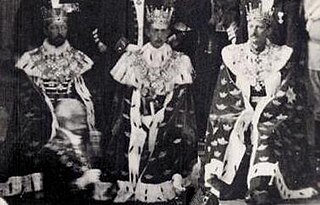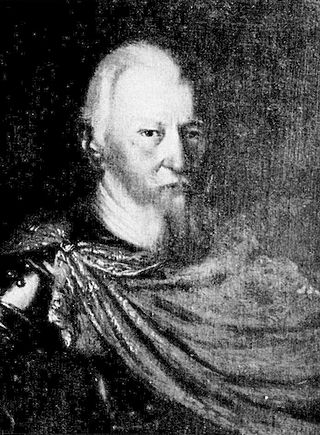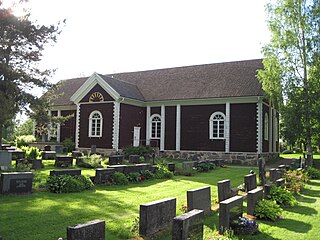Related Research Articles

Johan Ludvig Runeberg was a Finnish priest, lyric and epic poet. He wrote exclusively in Swedish. He is considered a national poet of Finland. He is the author of the lyrics to Vårt land which became the Finnish national anthem. Runeberg was also involved in the modernization of the Finnish Lutheran hymnal and produced many texts for the new edition.

Matinkylä is one of the major districts of Espoo, a city on the southern coast of Finland. Matinkylä sits between the Länsiväylä highway and the coast of the Gulf of Finland, between the areas of Haukilahti and Iivisniemi.

The Swedish nobility has historically been a legally and/or socially privileged class in Sweden, and part of the so-called frälse. The archaic term for nobility, frälse, also included the clergy, a classification defined by tax exemptions and representation in the diet. Today the nobility does not maintain its former legal privileges although family names, titles and coats of arms are still protected. The Swedish nobility consists of both "introduced" and "unintroduced" nobility, where the latter has not been formally "introduced" at the House of Nobility (Riddarhuset). The House of Nobility still maintains a fee for male members over the age of 18 for upkeep on pertinent buildings in Stockholm.

Henry was a medieval English clergyman. He came to Sweden with Cardinal Nicholas Breakspeare in 1153 and was most likely designated to be the new Archbishop of Uppsala, but the independent church province of Sweden could only be established in 1164 after the civil war, and Henry would have been sent to organize the Church in Finland, where Christians had already existed for two centuries.

Duchies in Sweden have been allotted since the 13th century to powerful Swedes, almost always to princes of Sweden and wives of the latter. From the beginning these duchies were often centers of regional power, where their dukes and duchesses had considerable executive authority of their own, under the central power of their kings or queens regnant. Since the reign of King Gustav III the titles have practically been nominal, with which their bearers only rarely have enjoyed any ducal authority, though often maintaining specially selected leisure residences in their provinces and some limited measure of cultural attachment to them.
Kvenland, known as Cwenland, Qwenland, Kænland, and similar terms in medieval sources, is an ancient name for an area in Fennoscandia and Scandinavia. Kvenland, in that or nearly that spelling, is known from an Old English account written in the 9th century, which used information provided by Norwegian adventurer and traveler Ohthere, and from Nordic sources, primarily Icelandic. A possible additional source was written in the modern-day area of Norway. All known Nordic sources date from the 12th and 13th centuries. Other possible references to Kvenland by other names and spellings are also discussed here.

The House of Bjälbo, also known as the House of Folkung, was a Swedish family that produced several medieval bishops, jarls and kings of Sweden. It also provided three kings of Norway and one king of Denmark in the 14th century.

The Finnish nobility was historically a privileged class in Finland, deriving from its period as part of Sweden and the Russian Empire. Noble families and their descendants are still a part of Finnish republican society, but except for the titles themselves, no longer retain any specific or granted privileges. A majority of Finnish nobles have traditionally been Swedish-speakers using their titles mostly in Swedish. The Finnish nobility today has some 6,000 male and female members.
Lordship of the Manor of Harviala was a medieval frälse possession in Finland.

The Kurki family or Kurck, also known as the family of Laukko, is a Finnish noble family tracing its lineage back to the late 14th century. It produced several historically prominent persons. The family is usually divided into several lineages, as it continued through female succession.
In Finland, a person must have a surname and at least one given name with up to four given names permitted. Surnames are inherited either patrilineally or matrilineally, while given names are usually chosen by a person's parents. Finnish names come from a variety of dissimilar traditions that were consolidated only in the early 20th century. The first national act on names came into force in 1921, and it made surnames mandatory. Between 1930 and 1985, the Western Finnish tradition whereby a married woman took her husband's surname was mandatory. Previously in Eastern Finland, this was not necessarily the case. On 1 January 2019, the reformed Act on Forenames and Surnames came into force.
Kurki of Laukko refers to a Finnish noble family.

Axel Jönsson Kurck, born 1555, died 30 March 1630 in Nakkila) was a colonel in the Swedish army and nobleman. He was a member of the Kurki of Laukko family.

Edvin Leonard Hugo Endre is a Swedish actor, best known for his role as 'Mister' in the 2013 Swedish comedy film Studentfesten. From 2014 to 2016, he portrayed the recurring character Erlendur, son of King Horik, in the historical drama television series Vikings.

The Lizard, Op. 8, is a theatre score for string ensemble—comprising six to nine musicians—by the Finnish composer Jean Sibelius; he wrote the music in 1909 to accompany the Finnish author Mikael Lybeck's 1908 three-act, Symbolist play of the same name. The story, which takes place at the Eyringe family estate, is a romantic triangle: Alban, an overly-sensitive nobleman with an artist's soul, is engaged to Elisiv, the tender and virtuous nurse who had cared for his late father; however, he struggles to resist the carnal advances of his older cousin Adla, a cunning temptress whose plot to seduce him turns lethal. Sibelius contributed music for two scenes in Act II: Tableau 1, in which Alban plays his violin at the family burial chapel, hoping to summon his deceased relatives; and Tableau 3, in which Elisiv during a fever dream hears "strange" music and, later with three Eyringe ghosts, ponders the thin line between life and death.

Tottijärvi is a village and a former municipality in Nokia, Finland. It is located by the lake Pyhäjärvi, about 30 kilometres southwest of the city of Tampere. The population of Tottijärvi is 717 (2008).

Sadan miekan mies is a Finnish historical adventure comedy film from 1951 directed by Ilmari Unho. The film takes place in the 1630s in the Finnish county Varsinais-Suomi, and tells the story of a heroic swordsman on an assignment from the king, and on their journey, the swordsman and he's partner encounter foes and damsels. The film was first shown on television on 7 March 1964.

Matti Lives in Finland is a book by Swedish writer Astrid Lindgren, with the photos by Anna Riwkin-Brick. In 1968 the book was published at Rabén & Sjögren.

Hatanpää Manor was a manor in the area of the current city of Tampere on the shores of Lake Pyhäjärvi in Pirkanmaa, Finland. It was founded in the 1690s, but the current main building of Hatanpää Manor, designed by architect Sebastian Gripenberg, was completed in 1885. The manor has preserved the manor park on the Hatanpää's peninsula, as well as the main building and villa building built in the late 19th century. The former land areas of the manor are now residential and industrial areas.
David's Rebellion also known as the Peasants' Revolt of 1438 was a peasant revolt from 1438 to 1439 in Upper Satakunta, spreading from Vesilahti to Lempäälä. The rebellion was propagated by David of Ania, also called Crazy David of Upper Satakunta, who was a peasant leader, in response to increased tax burdens.
References
- ↑ "Google Translate". translate.google.com. Retrieved 2019-11-17.